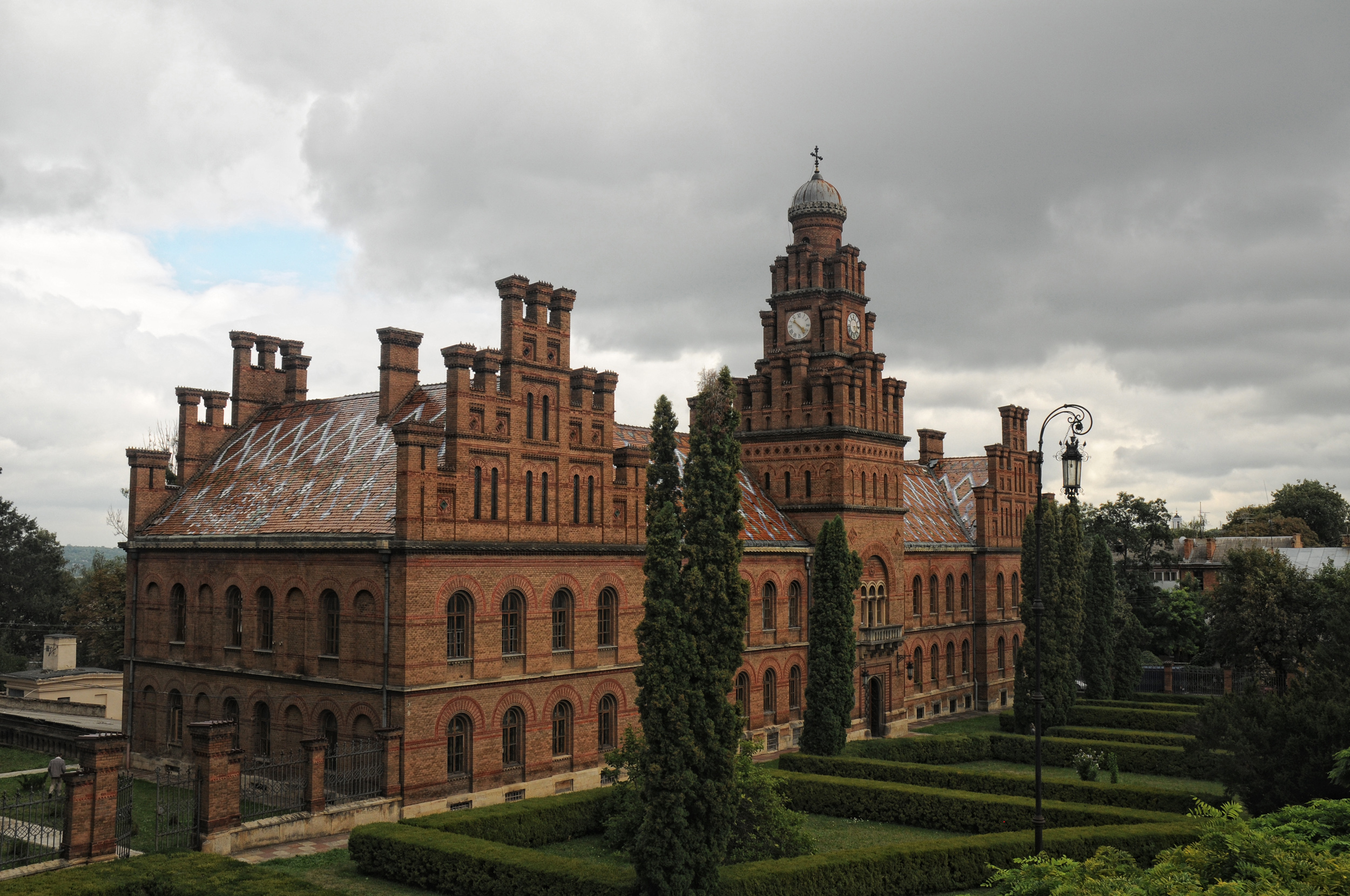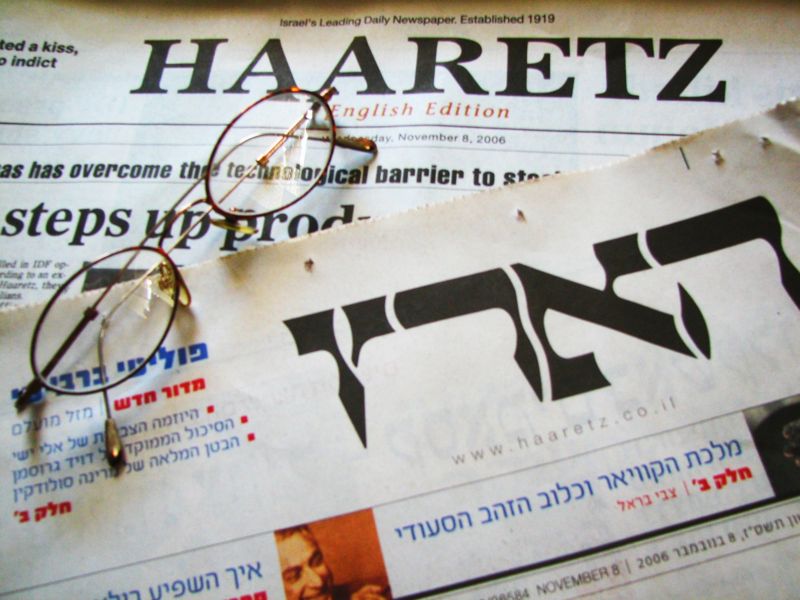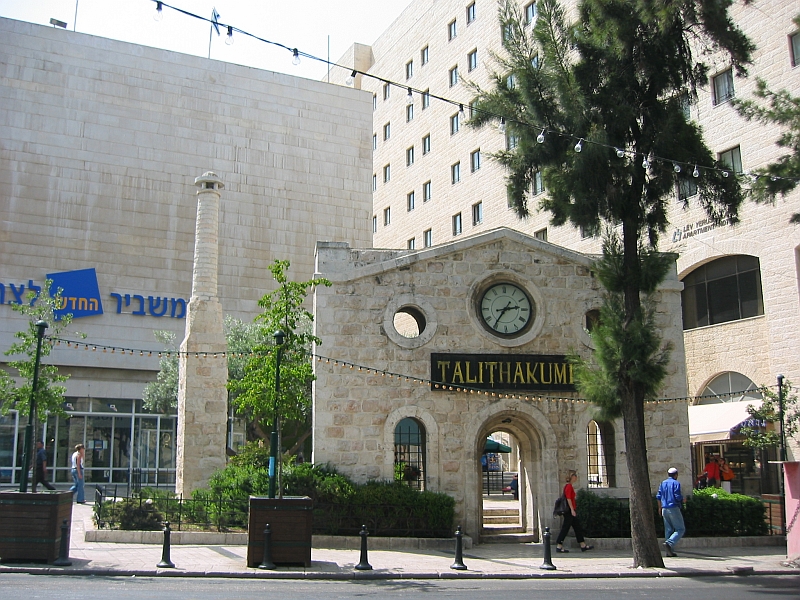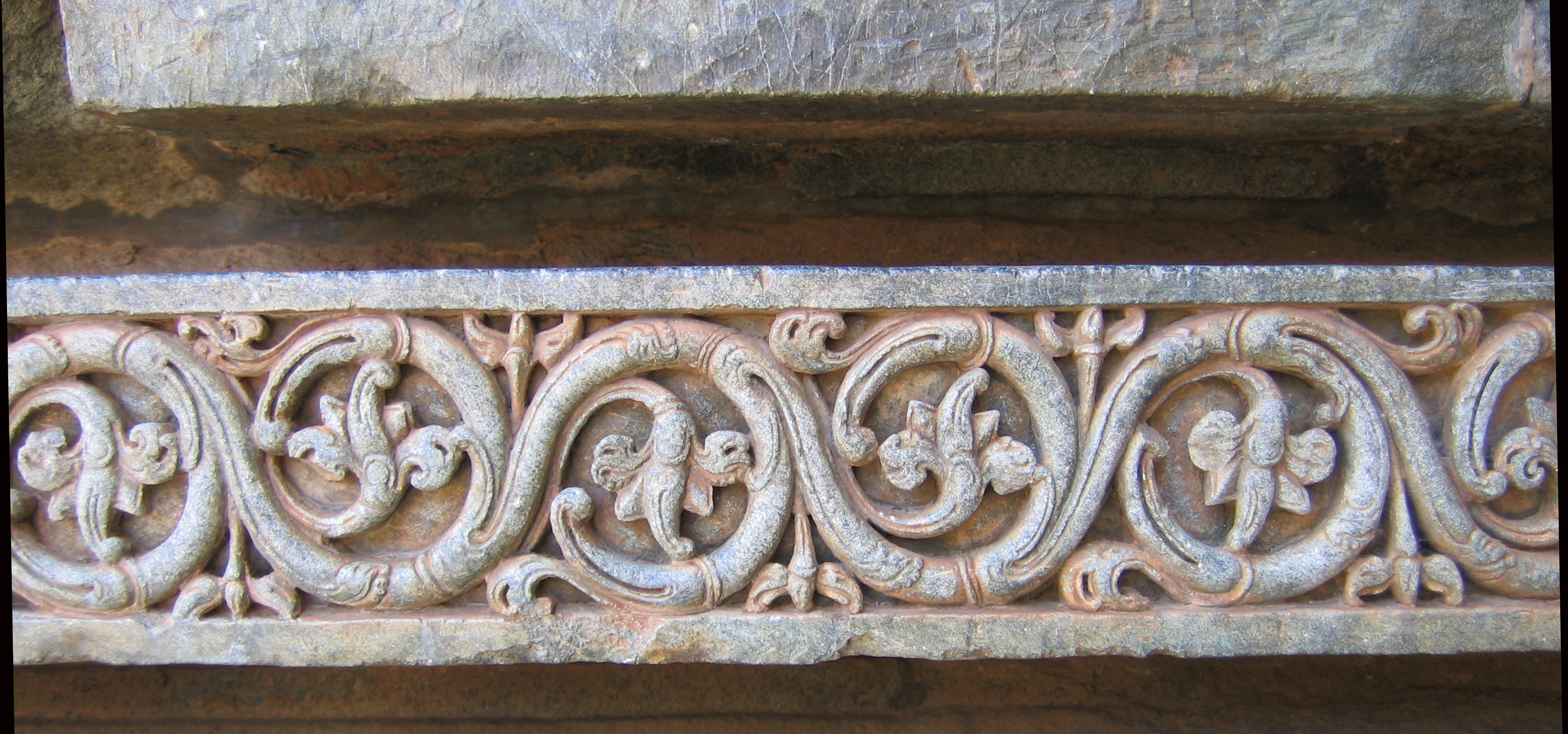|
Mashiach Borochoff House
Mashiach Borochoff House () is a historical building located at 64 Jaffa Road in Jerusalem. Built in 1908 in eclectic style, its entrance is covered by an arcade with pointed arches supported by pseudo-Corinthian columns. The gate, in the style of 17th-century Georgian architecture, consists of two pillars connected by ironwork. A lion statue is placed atop each pillar. The house was built by Mashiach Borochoff, a wealthy Bukharan Jewish merchant, as a family residence. In 1947, a year after Borochoff's death, the property was sold to Barclays bank. It has functioned as a bank branch since that time. History Mashiach Borochoff was a wealthy Bukharan Jewish textile merchant who resided in Moscow. The youngest son of Baruch Borochoff, he accompanied his father to Palestine in 1882 when his father made aliyah and settled in the Nahalat Shiv'a neighborhood. Mashiach returned to Russia to run the family's business operations in Moscow and Tashkent. In 1919 he moved the family's asse ... [...More Info...] [...Related Items...] OR: [Wikipedia] [Google] [Baidu] |
Eclecticism In Architecture
Eclecticism in architecture is a 19th and 20th century architectural style in which a single piece of work incorporates eclecticism, a mixture of elements from previous historical styles to create something that is new and original. In architecture and interior design, these elements may include structural features, furniture, decorative motives, distinct historical ornament, traditional cultural motifs or styles from other Country, countries, with the mixture usually chosen based on its suitability to the project and overall aesthetic value. The term is also used of the many architects of the 19th and early 20 (number), 20th centuries who designed buildings in a variety of styles according to the wishes of their clients, or their own. The styles were typically Revivalism (architecture), revivalist, and each building might be mostly or entirely consistent within the style selected, or itself an eclectic mixture. Gothic Revival architecture, especially in churches, was most likel ... [...More Info...] [...Related Items...] OR: [Wikipedia] [Google] [Baidu] |
Joseph Navon
Yosef Navon (; 1858–1934) was a Jerusalem businessman and the man principally responsible for the construction of the Jaffa–Jerusalem railway. For his effort, Navon was awarded the Légion d'honneur from the French government, and the Medjidie from the Turkish government, where he was also promoted to the title of Bey. Biography Navon was born in Jerusalem to a Sephardic Jewish family which was part of Jerusalem's wealthy Sephardic elite.Anthony S. Travis (2009), ''On Chariots with Horses of Fire and Iron'', Hebrew University Magnes Press, p. 27 His father, rabbi Eliyahu Pinchas Navon, was selected by the Ottomans to represent the Yishuv Jews at the Porte, and his mother came from the Amzallag family, also of the Sephardic elite in the Yishuv. He was educated in a Jerusalem yeshiva and finished his education at a school in Marseille. Navon married Guishe Frumkin, who had been born in the Russian Empire and moved to the Yishuv with her family as a child. She was the sister ... [...More Info...] [...Related Items...] OR: [Wikipedia] [Google] [Baidu] |
Rough Guides
Rough Guides is a travel company that offers tailor-made trips planned and arranged by local travel experts based in destinations around the world. Originally established as a guidebook publisher in 1982, Rough Guides expanded into customized travel services in 2018. History The first Rough Guide was ''The Rough Guide to Greece''. In 1995, when Rough Guides were selling around a million books a year, Mark Ellingham entered into a pioneering agreement with HotWired Ventures, the digital offshoot of Wired Ventures, the then-publisher of WIRED magazine. The deal offered free online access to the full text of ''The Rough Guide to the USA'' via the World Beat section of HotWired. Ellingham stated at the time that publishing the guides online would facilitate easier updates. "If you could send me an e-mail from Senegal saying this hotel's closed down, I would just key it in," he told the ''San Francisco Chronicle''. "The online book would take on a life of its own". In May 2007, M ... [...More Info...] [...Related Items...] OR: [Wikipedia] [Google] [Baidu] |
Haaretz
''Haaretz'' (; originally ''Ḥadshot Haaretz'' – , , ) is an List of newspapers in Israel, Israeli newspaper. It was founded in 1918, making it the longest running newspaper currently in print in Israel. The paper is published in Hebrew language, Hebrew and English language, English in the Berliner (format), Berliner format, and is also available online. In North America, it is published as a weekly newspaper, combining articles from the Friday edition with a roundup from the rest of the week. ''Haaretz'' is Israel's newspaper of record. It is known for its Left-wing politics, left-wing and Liberalism in Israel, liberal stances on domestic and foreign issues. ''Haaretz'' has the third-largest Print circulation, circulation in Israel. It is widely read by international observers, especially in its English edition, and discussed in the international press. According to the Center for Research Libraries, among Israel's daily newspapers, "''Haaretz'' is considered the most infl ... [...More Info...] [...Related Items...] OR: [Wikipedia] [Google] [Baidu] |
Israel Discount Bank
Israel Discount Bank, Ltd. () is an Israeli banking institution that offers a range of financial services, including retail banking, commercial banking, private banking, and financial services. The bank, headquartered in Tel Aviv, operates 112 branches throughout Israel. Founded on 5 April 1935 in Tel Aviv, Mandatory Palestine, the bank has grown to become a significant player in the Israeli banking industry. It is a public company listed on the Tel Aviv Stock Exchange under the symbol DSCT and is included in the Tel Aviv 35 Index. The bank's product portfolio includes credit cards, consumer banking, corporate banking, finance and insurance, investment banking, mortgage loans, private banking, private equity, savings, securities, asset management, and wealth management. It serves its customers through various channels including physical branches, online banking, and mobile banking. As of 2018, the bank reported revenues of ₪ 9.02 billion, operating income of ₪ 1.5 bill ... [...More Info...] [...Related Items...] OR: [Wikipedia] [Google] [Baidu] |
Kedem Auction House
The Kedem Auction House was founded in 2008 in Jerusalem as an auction house for Judaica and Israeliana (i.e. items relating to Israel and the pre-state Zionist period). Kedem is one of the leading auction houses in this field in Israel and worldwide. History Kedem was founded by Meron Eren (born 1963), a farmer by profession, Avishai Galer (born 1974) a rabbi and teacher who lives in Modi'in Illit, and Eran Reiss (born 1966). The owners dealt for many years with Hebrew ancient books and manuscripts related to the history of the Jewish people and their culture. While Galer specialized in religious books and rabbinical manuscripts, Eren specialized in Jewish and Modern Israeli culture. Reiss later left the auction house. At first the company's offices were located in the industrial park of Givat Shaul, the auctions taking place in Belgium House in the Givat Ram Campus of the Hebrew University. In 2012 an "Israeli art item auction" took place at the Nachum Gutman Museum. Later ... [...More Info...] [...Related Items...] OR: [Wikipedia] [Google] [Baidu] |
Micrography
Micrography (from Greek language, Greek, literally small-writing – "Μικρογραφία"), also called microcalligraphy, is a Jewish form of calligrams developed in the 9th century, with parallels in Christianity and Islam, (French) utilizing minute Hebrew alphabet, Hebrew letters to form representational, geometric and abstract designs. Colored micrography is especially distinctive because these rare artworks are customarily rendered in black and white. Description The artwork is created from text that forms an image when viewed at a distance, creating an interplay between the text and image. The photomosaic, whose tiny individual images form a mosaic when viewed from a distance, is a modern analogue. Another modern analogue is ASCII art, where ASCII or extended ASCII characters are arranged to f ...[...More Info...] [...Related Items...] OR: [Wikipedia] [Google] [Baidu] |
Mahane Yehuda Police Station
Mahane Yehuda Police Station is a historic two-story building located at 107 Jaffa Road in Jerusalem. Constructed in stages during the nineteenth century, it was built to house the List of Consuls-General of the United Kingdom to Jerusalem, British Consul-General of Jerusalem, List of Consuls-General of the United Kingdom to Jerusalem, Noel Temple Moore, and his family, and was home to other British consuls until World War I. In 1920, when the Mandatory Palestine, British mandatory government went into effect, the house was converted into a police station. Following the establishment of the state of Israel in 1948, the Jerusalem District lost and found department was added to the police station. The building is noted for the two stone lions mounted on pillars that originally flanked the entrance in the wall surrounding the property. During infrastructure work for the construction of the Jerusalem Light Rail, the wall and front garden were removed to accommodate the widening of the s ... [...More Info...] [...Related Items...] OR: [Wikipedia] [Google] [Baidu] |
David Kroyanker
David Kroyanker (; born 1939) is an Israeli architect and architectural historian of Jerusalem. He has written dozens of popular books about Jerusalem neighborhoods, streets, and buildings, and urban planning. Biography Kroyanker was born and raised in the Rehavia neighborhood of Jerusalem. His father, Dr. , was a German Zionist activist, journalist and art researcher. His mother, Dr. Edith Krojanker, was a lawyer in the public sector. His father died of cancer when Kroyanker was six years old. He attended a high school located next to the Hebrew University of Jerusalem and served in the Paratroopers Brigade of the Israel Defense Forces from 1958 to 1961. Kroyanker studied at the Architectural Association School of Architecture in London from 1963 to 1968. He returned to Israel to work as an architect for a firm headed by David Resnick in Jerusalem, and moved to the urban planning department of the Jerusalem Municipality under Meron Benvenisti in 1970. From 1973 to 1981 he ... [...More Info...] [...Related Items...] OR: [Wikipedia] [Google] [Baidu] |
Overthrow (structure)
In wrought ironwork, the overthrow, particularly popular in the Baroque era commencing in the 17th century, refers to the crowning section of ornamental wrought ironwork which forms a decorative crest above a wrought-iron gate; the overthrow provides some stabilizing structure tying together supporting piers on either side of the swinging sections. The piers may be masonry or of assembled sections of wrought iron. Aside from this stabilizing feature, the overthrow was largely freed of constraints of barring passage of animals or people. Consequently, the iron master was free to express his fancy. Overthrows often feature monograms or cyphers, armorial crests or supporters, and even fully realized coats of arms. Examples Some outstanding English and Welsh examples of overthrows: *Chirk Castle, Denbigh. 1719. By Robert Davies, a pupil of Jean Tijou. *Leeswood, Mold, Clwyd. The "White Gates". 1726 By Robert Davies. * Eaton Hall, Cheshire. Golden Gates. c. 1730. By the Davies Bro ... [...More Info...] [...Related Items...] OR: [Wikipedia] [Google] [Baidu] |
Scroll (art)
The scroll in art is an element of ornament and graphic design featuring spirals and rolling incomplete circle motifs, some of which resemble the edge-on view of a book or document in scroll form, though many types are plant-scrolls, which loosely represent plant forms such as vines, with leaves or flowers attached. Scrollwork is a term for some forms of decoration dominated by spiralling scrolls, today used in popular language for two-dimensional decorative flourishes and arabesques of all kinds, especially those with circular or spiralling shapes. Scroll decoration has been used for the decoration of a vast range of objects, in all Eurasian cultures, and most beyond. A lengthy evolution over the last two millennia has taken forms of plant-based scroll decoration from Greco-Roman architecture to Chinese pottery, and then back across Eurasia to Europe. They are very widespread in architectural decoration, woodcarving, painted ceramics, mosaic, and illuminated manuscripts ... [...More Info...] [...Related Items...] OR: [Wikipedia] [Google] [Baidu] |
Rosette (design)
A rosette is a round, stylized flower design. Origin The rosette derives from the natural shape of the botanical rosette, formed by leaves radiating out from the stem of a plant and visible even after the flowers have withered. History The rosette design is used extensively in sculptural objects from antiquity, appearing in Mesopotamia, and in funeral steles' decoration in Ancient Greece. The rosette was another important symbol of Ishtar which had originally belonged to Inanna along with the Star of Ishtar. It was adopted later in Romaneseque and Renaissance architecture, and also common in the art of Central Asia, spreading as far as India where it is used as a decorative motif in Greco-Buddhist art. Ancient origins One of the earliest appearances of the rosette in ancient art is in early fourth millennium BC Egypt. Another early Mediterranean occurrence of the rosette design derives from Minoan Crete; Among other places, the design appears on the Phaistos Disc, r ... [...More Info...] [...Related Items...] OR: [Wikipedia] [Google] [Baidu] |





